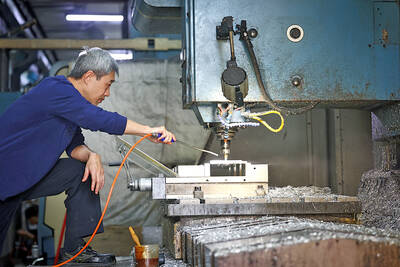Memorychip maker Mosel Vitelic Inc (茂矽) said yesterday that a settlement it has reached with 33 US states to resolve price-fixing allegations will have only limited impact on the company’s operations.
Mosel Vitelic and five other dynamic random access memory (DRAM) chipmakers reached a US$173 million agreement to settle price-fixing allegations with the 33 states.
The five other manufacturers are Micron Technology Inc of the US, NEC Electronics America Inc, Infineon Technologies AG of Germany, Hynix Semiconductor Inc of South Korea and Elpida Memory Inc of Japan.
While Mosel Vitelic declined to disclose the share it will pay for the settlement, it said it has assigned an unspecified provision for litigation costs and settlement payments, but added that the litigation process had incurred considerable costs for the company.
The US Department of Justice launched probes into price-fixing claims involving the six DRAM firms in 2002, alleging that all six colluded to fix prices between 1998 and 2002. The 33 US states moved to file a class-action lawsuit against the companies in 2006.
California Attorney General Edmund Brown Jr, who was involved in the investigation, said salespeople and management of the DRAM firms met frequently to exchange pricing information and agreed to overcharge customers.
Earlier this month, the US Department of Justice indicted Taiwanese flat-panel maker AU Optronics Corp (友達光電) and six of its executives on charges of price-fixing. The company has vowed to fight the charges to clear its name and protect its reputation and credibility.

SEEKING CLARITY: Washington should not adopt measures that create uncertainties for ‘existing semiconductor investments,’ TSMC said referring to its US$165 billion in the US Taiwan Semiconductor Manufacturing Co (TSMC, 台積電) told the US that any future tariffs on Taiwanese semiconductors could reduce demand for chips and derail its pledge to increase its investment in Arizona. “New import restrictions could jeopardize current US leadership in the competitive technology industry and create uncertainties for many committed semiconductor capital projects in the US, including TSMC Arizona’s significant investment plan in Phoenix,” the chipmaker wrote in a letter to the US Department of Commerce. TSMC issued the warning in response to a solicitation for comments by the department on a possible tariff on semiconductor imports by US President Donald Trump’s

The government has launched a three-pronged strategy to attract local and international talent, aiming to position Taiwan as a new global hub following Nvidia Corp’s announcement that it has chosen Taipei as the site of its Taiwan headquarters. Nvidia cofounder and CEO Jensen Huang (黃仁勳) on Monday last week announced during his keynote speech at the Computex trade show in Taipei that the Nvidia Constellation, the company’s planned Taiwan headquarters, would be located in the Beitou-Shilin Technology Park (北投士林科技園區) in Taipei. Huang’s decision to establish a base in Taiwan is “primarily due to Taiwan’s talent pool and its strength in the semiconductor

Industrial production expanded 22.31 percent annually last month to 107.51, as increases in demand for high-performance computing (HPC) and artificial intelligence (AI) applications drove demand for locally-made chips and components. The manufacturing production index climbed 23.68 percent year-on-year to 108.37, marking the 14th consecutive month of increase, the Ministry of Economic Affairs said. In the first four months of this year, industrial and manufacturing production indices expanded 14.31 percent and 15.22 percent year-on-year, ministry data showed. The growth momentum is to extend into this month, with the manufacturing production index expected to rise between 11 percent and 15.1 percent annually, Department of Statistics

An earnings report from semiconductor giant and artificial intelligence (AI) bellwether Nvidia Corp takes center stage for Wall Street this week, as stocks hit a speed bump of worries over US federal deficits driving up Treasury yields. US equities pulled back last week after a torrid rally, as investors turned their attention to tax and spending legislation poised to swell the US government’s US$36 trillion in debt. Long-dated US Treasury yields rose amid the fiscal worries, with the 30-year yield topping 5 percent and hitting its highest level since late 2023. Stocks were dealt another blow on Friday when US President Donald